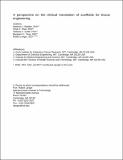| dc.contributor.author | Tang, Benjamin C. | |
| dc.contributor.author | Webber, Matthew | |
| dc.contributor.author | Langer, Robert S | |
| dc.contributor.author | Khan, Omar Fizal | |
| dc.contributor.author | Sydlik, Stefanie Arlene | |
| dc.date.accessioned | 2016-08-30T21:40:58Z | |
| dc.date.available | 2016-08-30T21:40:58Z | |
| dc.date.issued | 2014-09 | |
| dc.date.submitted | 2014-07 | |
| dc.identifier.issn | 0090-6964 | |
| dc.identifier.issn | 1573-9686 | |
| dc.identifier.uri | http://hdl.handle.net/1721.1/104085 | |
| dc.description.abstract | Scaffolds have been broadly applied within tissue engineering and regenerative medicine to regenerate, replace, or augment diseased or damaged tissue. For a scaffold to perform optimally, several design considerations must be addressed, with an eye toward the eventual form, function, and tissue site. The chemical and mechanical properties of the scaffold must be tuned to optimize the interaction with cells and surrounding tissues. For complex tissue engineering, mass transport limitations, vascularization, and host tissue integration are important considerations. As the tissue architecture to be replaced becomes more complex and hierarchical, scaffold design must also match this complexity to recapitulate a functioning tissue. We outline these design constraints and highlight creative and emerging strategies to overcome limitations and modulate scaffold properties for optimal regeneration. We also highlight some of the most advanced strategies that have seen clinical application and discuss the hurdles that must be overcome for clinical use and commercialization of tissue engineering technologies. Finally, we provide a perspective on the future of scaffolds as a functional contributor to advancing tissue engineering and regenerative medicine. | en_US |
| dc.description.sponsorship | National Institutes of Health (U.S.) (Ruth Kirschstein National Research Service Award (F32DK101335)) | en_US |
| dc.description.sponsorship | Juvenile Diabetes Research Foundation International (a Postdoctoral Fellowship (3-2011-310)) | en_US |
| dc.publisher | Springer US | en_US |
| dc.relation.isversionof | http://dx.doi.org/10.1007/s10439-014-1104-7 | en_US |
| dc.rights | Creative Commons Attribution-Noncommercial-Share Alike | en_US |
| dc.rights.uri | http://creativecommons.org/licenses/by-nc-sa/4.0/ | en_US |
| dc.source | Springer US | en_US |
| dc.title | A Perspective on the Clinical Translation of Scaffolds for Tissue Engineering | en_US |
| dc.type | Article | en_US |
| dc.identifier.citation | Webber, Matthew J., Omar F. Khan, Stefanie A. Sydlik, Benjamin C. Tang, and Robert Langer. “A Perspective on the Clinical Translation of Scaffolds for Tissue Engineering.” Ann Biomed Eng 43, no. 3 (September 9, 2014): 641–656. | en_US |
| dc.contributor.department | Massachusetts Institute of Technology. Institute for Medical Engineering & Science | en_US |
| dc.contributor.department | Harvard University--MIT Division of Health Sciences and Technology | en_US |
| dc.contributor.department | Massachusetts Institute of Technology. Department of Chemical Engineering | en_US |
| dc.contributor.department | Koch Institute for Integrative Cancer Research at MIT | en_US |
| dc.contributor.mitauthor | Webber, Matthew | en_US |
| dc.contributor.mitauthor | Langer, Robert | en_US |
| dc.contributor.mitauthor | Khan, Omar F. | en_US |
| dc.contributor.mitauthor | Sydlik, Stefanie A. | en_US |
| dc.contributor.mitauthor | Tang, Benjamin C. | en_US |
| dc.relation.journal | Annals of Biomedical Engineering | en_US |
| dc.eprint.version | Author's final manuscript | en_US |
| dc.type.uri | http://purl.org/eprint/type/JournalArticle | en_US |
| eprint.status | http://purl.org/eprint/status/PeerReviewed | en_US |
| dc.date.updated | 2016-05-23T12:16:39Z | |
| dc.language.rfc3066 | en | |
| dc.rights.holder | Biomedical Engineering Society | |
| dspace.orderedauthors | Webber, Matthew J.; Khan, Omar F.; Sydlik, Stefanie A.; Tang, Benjamin C.; Langer, Robert | en_US |
| dspace.embargo.terms | N | en |
| dc.identifier.orcid | https://orcid.org/0000-0003-3811-2369 | |
| dc.identifier.orcid | https://orcid.org/0000-0003-0624-3532 | |
| dc.identifier.orcid | https://orcid.org/0000-0003-4255-0492 | |
| mit.license | OPEN_ACCESS_POLICY | en_US |
